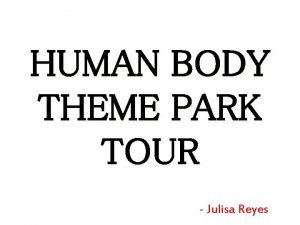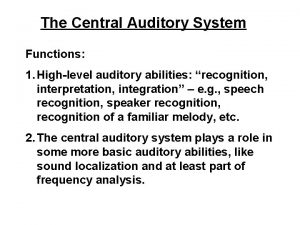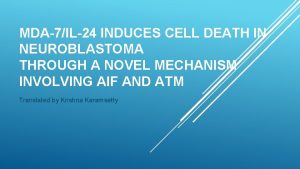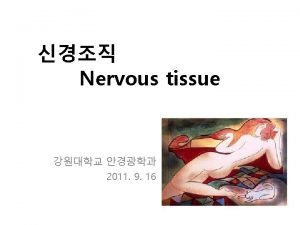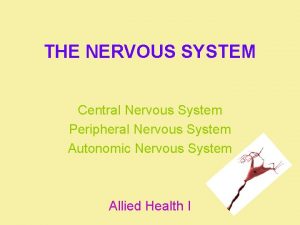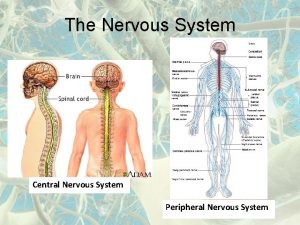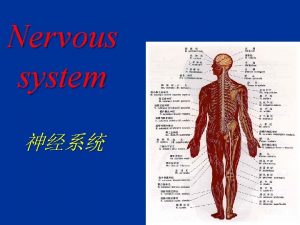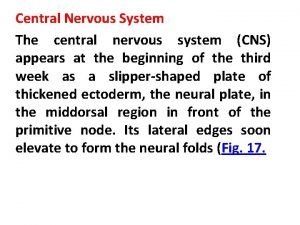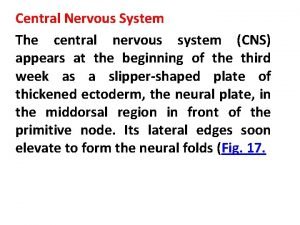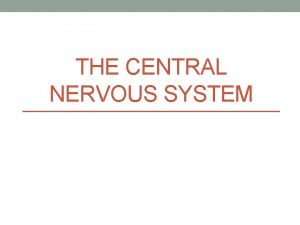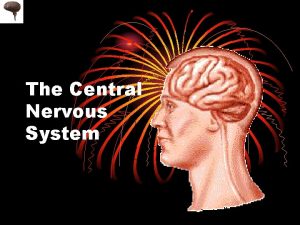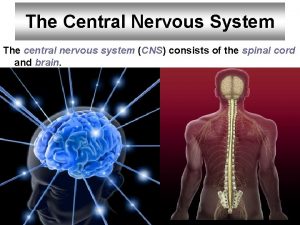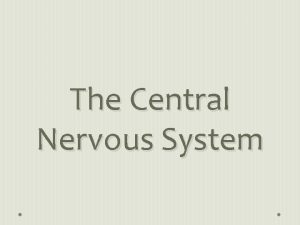Organization of the Nervous System A Central nervous























- Slides: 23

Organization of the Nervous System A. Central nervous system (CNS): a. Brain (intracranial part). b. Spinal cord (extracranial part). B. Peripheral nervous system (PNS): 1. Somatic (cranio-spinal) NS: a. Cranial nerves: 12 pairs attached to the brain. b. Spinal nerves: 31 attached to the spinal cord. 2. Autonomic NS: a. Sympathetic NS. b. Parasympathetic NS


Spinal Cord • • • Runs through the vertebral canal Extends from foramen magnum to second lumbar vertebra Regions – – – • Cervical Thoracic Lumbar Sacral Coccygeal Gives rise to 31 pairs of spinal nerves – All are mixed nerves • • Not uniform in diameter – Cervical enlargement: supplies upper limbs – Lumbar enlargement: supplies lower limbs Conus medullaris- tapered inferior end – Ends between L 1 and L 2 • Cauda equina - origin of spinal nerves extending inferiorly from conus medullaris.

Meninges • Connective tissue membranes – Dura mater: outermost layer; continuous with epineurium of the spinal nerves – Arachnoid mater: thin and wispy – Pia mater: bound tightly to surface • Forms the filum terminale – anchors spinal cord to coccyx • Forms the denticulate ligaments that attach the spinal cord to the dura • Spaces – Epidural: external to the dura • Anesthestics injected here • Fat-fill – Subdural space: serous fluid – Subarachnoid: between pia and arachnoid • Filled with CSF

Cross Section of Spinal Cord • Anterior median fissure and posterior median sulcus – deep clefts partially separating left and right halves • • Gray matter: neuron cell bodies, dendrites, axons – Divided into horns • Posterior (dorsal) horn • Anterior (ventral) horn • Lateral horn White matter – Myelinated axons – Divided into three columns (funiculi) • Ventral • Dorsal • lateral – Each of these divided into sensory or motor tracts

Cross section of Spinal Cord • Commissures: connections between left and right halves – Gray with central canal in the center – White • Roots – Spinal nerves arise as rootlets then combine to form dorsal and ventral roots – Dorsal and ventral roots merge laterally and form the spinal nerve


Blood supply of the spinal cord

Organization of Spinal Cord Gray Matter • Recall, it is divided into horns – Dorsal, lateral (only in thoracic region), and ventral • Dorsal half – sensory roots and ganglia • Ventral half – motor roots • Based on the type of neurons/cell bodies located in each horn, it is specialized further into 4 regions – – Somatic sensory (SS) - axons of somatic sensory neurons Visceral sensory (VS) - neurons of visceral sensory neur. Visceral motor (VM) - cell bodies of visceral motor neurons Somatic motor (SM) - cell bodies of somatic motor neurons

Gray Matter: Organization Figure 12. 31

White Matter in the Spinal Cord • Divided into three funiculi (columns) – posterior, lateral, and anterior – Columns contain 3 different types of fibers (Ascend. , Descend. , Trans. ) • Fibers run in three directions – Ascending fibers - compose the sensory tracts – Descending fibers - compose the motor tracts – Commissural (transverse) fibers - connect opposite sides of cord

White Matter: Pathway Generalizations

Descending (Motor) Pathways • Descending tracts deliver motor instructions from the brain to the spinal cord • Divided into two groups – Pyramidal, or corticospinal, tracts – Indirect pathways, essentially all others • Motor pathways involve two neurons – Upper motor neuron (UMN) – Lower motor neuron (LMN) • Also known as ‘anterior horn motor neuron” (also, final common pathway)

Pyramidal (Corticospinal) Tracts • Originate in the precentral gyrus of brain (aka, primary motor area) – I. e. , cell body of the UMN located in precentral gyrus • Pyramidal neuron is the UMN – Its axon forms the corticospinal tract • UMN synapses in the anterior horn with LMN – Some UMN decussate in pyramids = Lateral corticospinal tracts – Others decussate at other levels of s. c. = Anterior corticospinal tracts • LMN (anterior horn motor neurons) – Exits spinal cord via anterior root – Activates skeletal muscles • Regulates fast and fine (skilled) movements

Corticospinal tracts 1. 2. 3. 4. Location of UMN cell body in cerebral cortex Decussation of UMN axon in pyramids or at level of exit of LMN Synapse of UMN and LMN occurs in anterior horn of s. c. LMN axon exits via anterior root

Extrapyramidal Motor Tracts • Includes all motor pathways not part of the pyramidal system • Upper motor neuron (UMN) originates in nuclei deep in cerebrum (not in cerebral cortex) • UMN does not pass through the pyramids! • LMN is an anterior horn motor neuron • This system includes – – Rubrospinal Vestibulospinal Reticulospinal Tectospinal tracts • Regulate: – Axial muscles that maintain balance and posture – Muscles controlling coarse movements of the proximal portions of limbs – Head, neck, and eye movement

Extrapyramida l Tract Note: 1. UMN cell body location 2. UMN axon decussates in pons 3. Synapse between UMN and LMN occurs in anterior horn of S. C 3. LMN exits via ventral root 4. LMN axon stimulates skeletal muscle

Extrapyramidal (Multineuronal) Pathways • Reticulospinal tracts – originates at reticular formation of brain; maintain balance • Rubrospinal tracts – originate in ‘red nucleus’ of midbrain; control flexor muscles • Tectospinal tracts - originate in superior colliculi and mediate head and eye movements towards visual targets (flash of light)

Main Ascending Pathways • The central processes of first-order neurons branch diffusely as they enter the spinal cord and medulla • Some branches take part in spinal cord reflexes • Others synapse with second-order neurons in the cord and medullary nuclei

Three Ascending Pathways • The nonspecific and specific ascending pathways send impulses to the sensory cortex – These pathways are responsible for discriminative touch (2 pt. discrimination) and conscious proprioception (body position sense). • The spinocerebellar tracts send impulses to the cerebellum and do not contribute to sensory perception

Nonspecific Ascending Pathway • • • Include the lateral and anterior spinothalamic tracts Lateral: transmits impulses concerned with pain and temp. to opposite side of brain Anterior: transmits impulses concerned with crude touch and pressure to opposite side of brain 1 st order neuron: sensory neuron 2 nd order neuron: interneurons of dorsal horn; synapse with 3 rd order neuron in thalamus 3 rd order neuron: carry impulse from thalamus to postcentral gyrus

Specific and Posterior Spinocerebellar Tracts • Dorsal Column Tract 1. AKA Medial lemniscal pathway 2. Fibers run only in dorsal column 3. Transmit impulses from receptors in skin and joints 4. Detect discriminative touch and body position sense =proprioception • 1 st O. N. - a sensory neuron • synapses with 2 nd O. N. in nucleus gracilis and nucleus cuneatus of medulla • 2 nd O. N. - an interneuron • decussate and ascend to thalamus where it synapses with 3 rd O. N. • 3 rd-order (thalamic neurons) • transmits impulse to somatosensory cortex (postcentral gyrus) Spinocerebellar Tract • Transmit info. about trunk and lower limb muscles and tendons to cerebellum • No conscious sensation

Spinal Cord Trauma and Disorders • Severe damage to ventral root results in flaccid paralysis (limp and unresponsive) • Skeletal muscles cannot move either voluntarily or involuntarily • Without stimulation, muscles atrophy. • When only UMN of primary motor cortex is damaged • spastic paralysis occurs - muscles affected by persistent spasms and exaggerated tendon reflexes • Muscles remain healthy longer but their movements are no longer subject to voluntary control. • Muscles commonly become permanently shortened. • • Transection (cross sectioning) at any level results in total motor and sensory loss in body regions inferior to site of damage. • If injury in cervical region, all four limbs affected (quadriplegia) • If injury between T 1 and L 1, only lower limbs affected (paraplegia)
 Neuron process
Neuron process Nervous
Nervous Neuron processes
Neuron processes Major divisions
Major divisions Central nervous system amusement park
Central nervous system amusement park Cerebellum central nervous system
Cerebellum central nervous system Nervous tissue
Nervous tissue Central and peripheral nervous system
Central and peripheral nervous system Bser aer
Bser aer Electrical synapse vs chemical synapse
Electrical synapse vs chemical synapse Central nervous system for kids
Central nervous system for kids Nervous system and digestive system
Nervous system and digestive system Endocrine system and nervous system
Endocrine system and nervous system Mechanism of action of hormones
Mechanism of action of hormones Adh function
Adh function Central nervous sysytem
Central nervous sysytem Process organization in computer organization
Process organization in computer organization Block essay
Block essay Hình ảnh bộ gõ cơ thể búng tay
Hình ảnh bộ gõ cơ thể búng tay Lp html
Lp html Bổ thể
Bổ thể Tỉ lệ cơ thể trẻ em
Tỉ lệ cơ thể trẻ em Voi kéo gỗ như thế nào
Voi kéo gỗ như thế nào Glasgow thang điểm
Glasgow thang điểm




